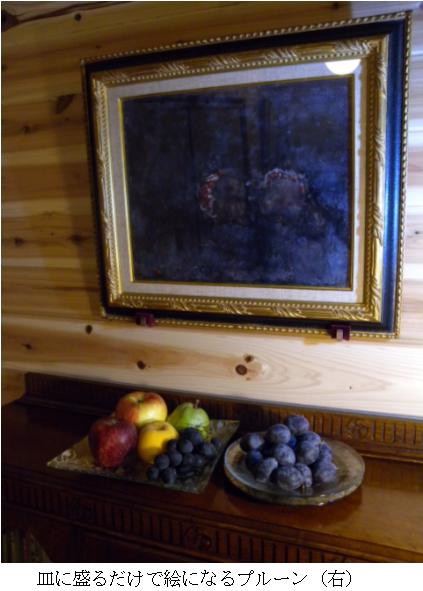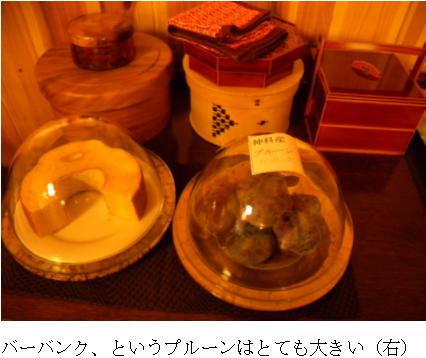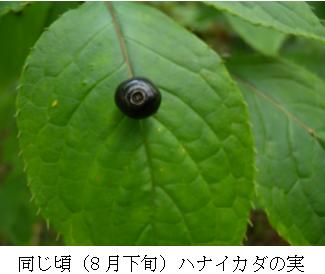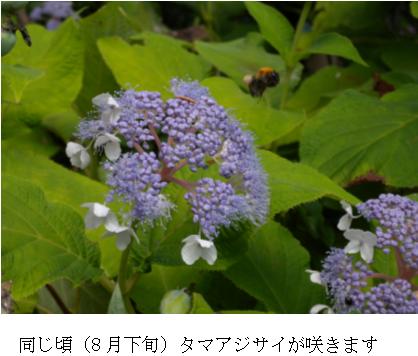前回の杏(あんず)が赤々と燃える暖炉の火や太陽のような暖色系の果実だとすれば、今回は、晴れた夜の空のように、また澄んだ湖の深い底のように、幽玄な黒に近い、青や藍色の寒色系の果実といえましょう。

東信地域の有名な果物の中で、私どもが毎年待ち焦がれるものとしてプルーンがあります。外国産の干しプルーンについてはよくスーパーなどで出回りますが、生のプルーンというのは案外知られていないかもしれません。
日本におけるプルーンの産地としては、軽井沢の隣の佐久市(臼田)が有名です。大きな青い宝石のような美しい果実で、皿に盛りつけてテーブルに置くだけでも絵になります。樹上で完熟した生のプルーンを皮ごとパクッといただくのは、どんな果実よりもみずみずしくおいしいと私は思います。
ちなみにプルーンは、東信では20を超える品種が栽培されており、収穫時期を次々とリレーしていきながら楽しめます。早い順に7月からアーリーリバー、オパール、ツァー、パープルアイ、シュガー、・・・・そして9月中旬頃に代表品種のサンプルーンが登場し、その後大型のプレジデントに至るまで10月の下旬頃まで続きます。
プルーンはアンズと違って、複数の品種をリレーすれば、とても長い期間「旬」を楽しむことのできる果実です。栽培農家の話によれば、近年は甘くて大型のものが好まれる傾向があるそうです。
車で行けばすぐ近くにある、とある栽培農家も兼ねる販売所では、プルーンの季節になると希少な品種も含め、ほとんどの品種を次々と販売していきます。

扱うプルーンの種類の多さにかけては、日本で一番であろうと思われます。他県のレストラン関係の会社の車も買い付けに来ているのを目にしました。
パートナーはプルーンが大好きなようで、また妙に研究熱心なところもあり、20種類近くの品種を購入し、生食したりジャムにしたりなどトライしていきました。生で食べるのはサンタス、でも、やっぱり定番中の定番である「サンプルーン」は、生で良し、加工して良し、と一番気に入っているようです。
なおプルーンのジャムは、青の果実からは想像できないような、美しい赤い色をしています。
そして、もう一つの青の果実、ブルーベリーもたくさんの品種があり、同様に収穫時期が異なり、それぞれ実の大きさや酸味、甘味などの味の特徴が異なります。このブルーベリーという果実もまた、パートナーの心の的を射てしまったようで、毎年、東御市の、とある栽培農家の元へ、さまざまな品種を時期を変えて買い求めに行くのに付き合わされております。

ブルーベリーは、寒冷地系と言われる北部ハイブッシュ系と、暖地系とされる南部ハイブッシュ系、さらには極寒冷地系の半樹高ハイブッシュ系、暖地系のラビットアイ系に大別されます(渡部順司『ブルーベリー大図鑑<品種読本>』マルモ出版、2006年)。当地で収穫されるのは、北部ハイブッシュ系の品種です。
私はブルーベリーに対しては、「食べる」ということ以外の興味はありませんので、ブルーベリーについては熱心に情報収集や栽培をした(15種類植えたものの収穫はごくわずかでしたが・・・)実績のあるパートナーの話を参考にしました。以下「 」はパートナーによる説明です。
「ブルーベリーは夏の果実であり、一定の時間を冷温にさらされないと収穫できないものです。日本のスーパーなどで出回るブルーベリーは、大半がアメリカ産、特にオレゴンとカリフォルニアのもので、ニュージーランドなど南半球のものもあります。当地(東信)では7月中旬からの1ヶ月間が旬で、たくさんの種類のブルーベリーが楽しめます。痛みやすいが生で食べるとおいしい、しかし未熟果はすっぱい、という微妙なタイミングでしか味わえない逸品として「ダロー」があります。これは、生産地の農場でしか味わえないブルーベリーです。「スパルタン」も味に定評がありますが、栽培の難しさでも知られています。」

そしてパートナーが特にお気に入りなのが「コリンズ」です。「ブルークロップ」や人気の「ブルーレイ」がそれに続きます。これらは甘味と酸味のバランスが良く、東信地区の気候風土と非常に相性が良く、おいしくなります。
ブルーベリーも最近は大粒で甘いものが好まれる傾向にあるようです。また品種ごとに、最適な食べ方があります。たとえば大粒で甘めなものは生食用、ジャムなどの加工用には酸味の強い小粒の「ジャージー」などが向いているといいます。
・・・などなど、マニアックな話題が尽きませんが、これから秋までの半年間は、またもや栽培農家や産直へ足繁く通う日々が続きます。木の恵みの魅力は、とどまるところを知りません。
『 ソフィアート・ガーデン物語 』 第7話 「木の恵み 2」
有限会社ソフィアート スタッフM( 竺原 みき )
関連する物語
>> 第6話「木の恵み 1」
>> 第7話「木の恵み 2」
>> 第56話「杏色の週末」
The Tale of Sophiart Garden
>>To the Previous Story | >>To the Next Story
Chapter 5
“The Bounty of Trees 2” A Special Chronicle (Part 2)
April 17, 2012
If apricots, as I wrote about last time, are fruits steeped in the warmth of a crackling hearth or the golden glow of the sun, then this time, I would like to speak of fruits that belong to an entirely different world—fruits veiled in hues of deep indigo and midnight blue, their colors reminiscent of a clear night sky or the shadowed depths of a still lake.
Among the many fruits that flourish in the eastern Shinshu region, there is one that we wait for with particular anticipation each year—the prune plum. Dried prunes from overseas are a familiar sight in supermarkets, yet the beauty of a fresh prune, ripened under the sun, remains an untold secret to many.
In Japan, the city of Saku (Usuda), just beyond Karuizawa, is known for its prune orchards. These fruits, with their rich blue sheen, resemble precious gemstones, their presence alone enough to transform an ordinary table into a still-life painting. To bite into a tree-ripened prune, its skin yielding to reveal the luscious flesh within, is to experience a kind of freshness that few other fruits can rival.
Here in Tōshin, more than twenty varieties of prunes are cultivated, their harvest unfolding in a relay from summer into autumn. The season begins in July, with the likes of Early River, Opal, and Czar, followed by Purple Eye, Sugar, and others. By mid-September, the Sanprune, the quintessential variety, takes center stage, and finally, the season extends into late Octoberwith the arrival of the majestic President variety.
Unlike the apricot, whose fleeting season comes and goes in the blink of an eye, the prune offers a lingering taste of summer, stretching out its presence through the careful succession of different cultivars. In recent years, growers tell me that larger, sweeter varieties have become especially popular.
There is a small farm shop nearby that grows and sells a remarkable range of prunes, including rare and unusual varieties. If one were to name the single best place in Japan to find the widest selection of prunes, this might very well be it. I have even seen cars from distant restaurant suppliers pulling up to stock up on these exquisite fruits.
My husband, a true devotee of prunes, approaches them with a peculiar blend of passion and scientific curiosity. Over the years, he has sampled nearly twenty varieties, testing them fresh, simmering them into jams, experimenting with their flavors in every possible way. His verdict? For eating fresh, Santas is a favorite. But in the end, the Sanprune reigns supreme—equally delightful when eaten as is or transformed through cooking.
Incidentally, prune jam, made from those deep blue fruits, turns a stunning shade of red, a transformation as unexpected as it is beautiful.
Another blue fruit that has captivated our household is the blueberry. Just like prunes, blueberries come in a dazzling array of varieties, each with its own nuances—some large and sweet, others small and sharp, each offering its own delicate balance of flavors. My husband, of course, has fallen completely under their spell. Every summer, without fail, I find myself accompanying him to a particular farm in Tōmi City, where he meticulously selects blueberries of different kinds, timing his visits with the changing harvest.
Blueberries are often divided into four major types:
1. Northern Highbush, suited for colder climates
2. Southern Highbush, which thrives in warmer regions
3. Half-Highbush, bred for extreme cold
4. Rabbiteye, a variety that flourishes in milder temperatures
According to Junji Watanabe’s Blueberry Encyclopedia (Marumo Publishing, 2006), the varieties grown in our region belong predominantly to the Northern Highbush group.
Unlike My husband, who studies blueberries as if unraveling a grand mystery, my own interest in them is purely culinary—I am content simply to enjoy eating them. So, I defer to his knowledge, gathered through years of research and even a modest attempt at cultivation (fifteen varieties planted, though the harvest was meager).
Here are some of his insights:
“Blueberries are fruits of the summer, yet they require a certain period of cold exposure before they can bear fruit. Most of the blueberries found in Japanese supermarkets come from Oregon and California, or sometimes New Zealand and other Southern Hemisphere regions. In Tōshin, the harvest lasts for about a month, starting in mid-July, during which time we can enjoy a variety of flavors.
The Darrow variety is a particular treasure—delicate, highly perishable, and impossible to find outside of a farm. It must be eaten at just the right moment, for if picked too early, it is unbearably sour. Spartan, another highly regarded variety, is known for its exceptional taste, but it is notoriously difficult to cultivate.”
Of all the varieties, My husband holds a special fondness for Collins, followed closely by Bluecrop and the ever-popular Blueray. These cultivars, thriving in Tōshin’s unique climate, develop a perfect balance of tartness and sweetness, making them truly exceptional.
Larger, sweeter berries are in fashion now, though each variety has its ideal purpose—the big, plump ones are best enjoyed fresh, while smaller, tangier varieties like Jersey lend themselves beautifully to jams and preserves.
And so, as summer fades into autumn, our pilgrimage to farms and marketswill continue.
There is no end to the enchantment of trees—their silent, generous gifts never cease to call us back.
The Tale of Sophiart Garden
Chapter 7:“The Bounty of Trees 2”
Miki Jikuhara, Sophiart Karuizawa
Related Stories:
>>Episode 6: “The Bounty of Trees 1”
>> Episode 7: “The Bounty of Trees 2”
>> Episode 56: “An Apricot-Colored Weekend”





